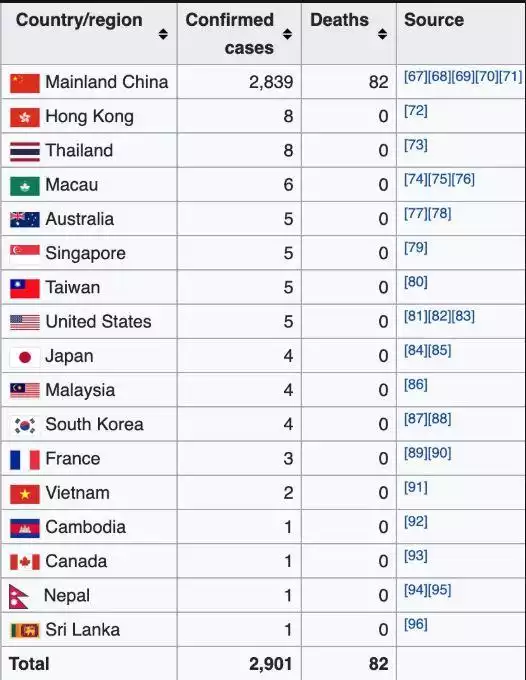“Coronavirus is a clear global recession threat”
News
|
Posted 29/01/2020
|
17523
You are no doubt sick of reading about the Coronavirus, however few if any of the articles we’ve scanned talk to the potential financial impact in any quantitative or meaningful way other than how it may hit our tourism industry. At this point too, we need to stress the word ‘potential’ as this is by no means a certain pandemic. That said, we came across the following brief article from David Llewellyn-Smith of Macro Business that deserves repeating verbatim as a concise outline of where this could lead from a financial sense.
“Coronavirus is a clear global recession threat
And Australia will get the absolute worst of it. Let’s begin with latest update virus update:

Plus:
- The mortality rate is still hovering around 3%.
- The virus has an incubation period anywhere from 1-14 days.
- It is more contagious than SARS.
- It is often asymptomatic with no fever.
- 5m people escaped the Wuhan blockade before it was imposed.
- China has quarantined 60m people and extended the CNY holiday period.
Yet the virus is clearly out of control and is going to get much worse.
In short, China moved too slowly and the thing is loose big time. There is a growing risk it will have to virtually shut down to stop it, if can succeed at all.
This trajectory now appears much worse than SARS. It is spreading faster, is more difficult to identify, China is much more open than 2003 with far more travel, and its role in the global economy is 10x greater.
Don’t forget that the SARS crisis, which had a near identical calendar timetable, did not peak until late April and it crashed Chinese GDP by 70% for one quarter. Sure, there was stimulus afterwards and it only lost 1.5% of GDP over the year but those options are more limited this time.
The truth is that this crisis is quickly escalating into a global recession threat via:
- A period of Chinese quarantine that stops its growth in its tracks for effectively two quarters.
- As Chinese demand evaporates from the global economy, its role in supply chains will disrupt everything in sight.
- Europe’s little recovery will fall down a dark well as its export machine is crushed.
- Global travel and oil will crater.
- That will infect the US junk bond market with widening spreads. In turn, stocks will keep falling.
- Bonds will be bid to the moon.
- DXY [US dollar index] will skyrocket as the safe haven of choice. Gold too.
- The wealth hit will rock the US consumer and spread the demand crush.
For Australia the outlook is dire:
- There will be more cases to impact retail.
- Tourism faces wipeout. Education will be severely hit.
- Commodity prices will crash, including iron ore.
- Immigration rates will crash.
- Property will slow as people stay home [and we’d suggest the impacts of less immigration].
- We have a weak economy barely operating above stall speed. Recession risk is clear.
For markets we can expect the following:
- A rising DXY.
- Record highs for bonds.
- Crashing commodity prices.
- A material stock correction with a possible bust for the ASX bubble.
- The danger is that these combine to produce some kind of contagion risk in bloated global corporate debt creating a follow-on credit event.
This all assumes that China succeeds in containing the outbreak. There is a material risk it will fail and global pandemic result. Loose modelling at the Fed suggests the Spanish Flu of 1918 cost 2% of GDP globally at first and much more longer term.
Policy will ride to the rescue but can’t do much to stem the tide while the virus gets worse. If China succeeds in containing it then the swoon will be a major buying opportunity with a violent snap back. The S&P500 bottomed in mid-March during SARS. Asian bourses one month later.
If China does not succeed then, nor some miracle cure appear, then brace for global and Australian recession.”
Just breaking down a couple of his points:
Should we see a simultaneous rise in the USD and Gold as he suggests that would see a double whammy for AUD gold as both the spot price rising and AUD dropping (against that rising USD and the abovementioned impacts on Australia) means a twofold upward force on the AUD gold price.
The “ASX bubble” he refers to is real. Many people think that just because our sharemarket only recently surpassed the pre GFC highs compared to the US sharemarkets smashing through all time highs well in excess of pre GFC means ours is less ‘bubble-like’. However the Financial Review just reported J P Morgan revealing our so called ‘blue chips’ in the ASX200 are now the most expensive in the developed world:
‘[JP Morgan’s] analysis, which is based on a one-year forward price-to-earnings measure, shows that the S&P/ASX 200 Index excluding financials and materials is trading at a 37.9 per cent premium to the global developed markets index.’
That figure in the context of all the ‘melt up’ talk on US shares must not be ignored. That the ASX is so heavily skewed toward our big banks who themselves are so heavily skewed into the fate of the Aussie property market is why smart investors are reducing their exposure to Aussie shares into gold and silver and bypassing cash given the inherent bank risk v (near nil) return in doing so.